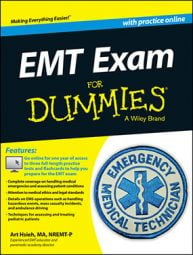You will need to be familiar with upper airway conditions for the EMT exam. Given that the airway is the only way for air to enter and exit the body, anything that partially or completely blocks it is troublesome, to say the least. Here’s a list of common conditions you should be familiar with, their signs and symptoms, and treatment options for each.
| Problem | Signs and Symptoms | Action Steps |
|---|---|---|
| Anaphylaxis causing major swelling of the upper airway | Exposure to an allergen such as a bee sting or peanuts; drooling; reddened oropharynx; muffled or whispered voice; possible hypotension. | Assist the patient in using an epinephrine injector; administer supplemental oxygen; ventilate as necessary to maintain oxygen saturation. |
| Croup | Usually occurs in young children; fever; stridor, raspy cough; sometimes relieved with a quick change in air temperature and/or humidity. | Have parent assist with positioning the child comfortably; administer blow-by, humidified oxygen. |
| Epiglottitis | High fever; drooling; reddened oropharynx; muffled or whispered voice; unable to lie down. | Don’t stick anything into the mouth! Help the patient into a comfortable position; administer blow-by oxygen. |
| Foreign body obstruction | Full obstruction: Air is unable to pass by the obstruction. No
noise or breathing sounds from airway; skin turns pale to cyanotic;
universal choking sign. Partial obstruction: Air is able to move past the obstruction. Patient may be coughing; audible stridor. |
Conscious patient: Administer abdominal thrusts (child and
adult) or chest thrusts/back blows (infant). If airway is partially
obstructed, encourage patient to cough; keep suction available and
prepare to act if airway becomes fully obstructed. Unconscious patient: Administer chest compressions (CPR). |
| Pertussis | Prolonged coughing spells; “whoop” sound when patient takes a deep breath after coughing; more prevalent in children; dark, thick mucous production; 1–2 week history of mild fever and coughing that worsens in duration and discomfort. | Wear personal protective equipment (PPE), including a HEPA mask; administer supplemental, humidified oxygen. |
| Tongue blocking the airway | Patient has altered mental status or is unresponsive, allowing tongue to relax and block the airway. Snoring sounds may be heard. In severe situations, breathing may become irregular or absent. | Perform head-tilt, chin-lift technique; if neck trauma suspected, utilize a modified jaw-thrust maneuver. Insert oropharyngeal or nasopharyngeal airway to help control the tongue. |
A 65-year-old male fell off a stepladder while attempting to replace a light bulb. You find him unresponsive to painful stimulus. He has a large hematoma to his left temple. He has slow, irregular, snoring respirations and his skin is pale, cool, and diaphoretic. After taking manual spine precautions, you should next
(A)apply a head-tilt, chin-lift and insert an oropharyngeal airway.
(B)administer high-flow oxygen with a nonrebreather mask.
(C)apply a modified jaw thrust and insert an oropharyngeal airway.
(D)ventilate with a bag-valve mask with high-flow oxygen.
The right answer is Choice (C). There are indications that a spinal injury may exist (mechanism of injury, a head injury, and a patient who is unable to communicate). A modified jaw thrust will open the patient’s airway while minimizing motion to the cervical spine, unlike a head-tilt, chin-lift procedure, Choice (A).
The patient's ventilation status is inadequate for simple supplemental oxygen, Choice (B). You’ll need to ventilate the patient, Choice (D), but not until after opening the airway.

